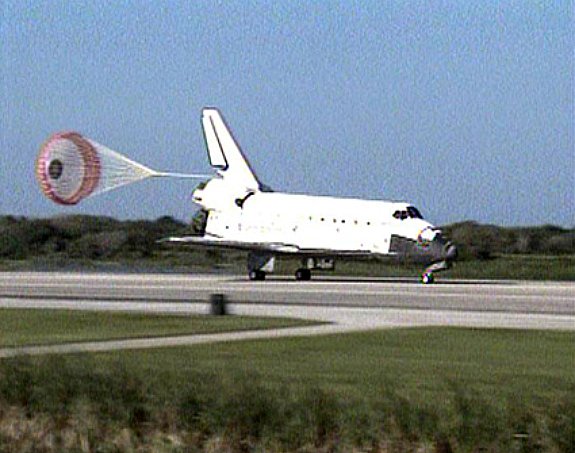Atlantis Lands For The Final Time
After 32 missions, the Space Shuttle Atlantis came home for the final time this morning:
KENNEDY SPACE CENTER, Fla. — Gliding into retirement after 32 missions covering 120 million miles, the shuttle Atlantis dropped out of orbit and returned to Earth on Wednesday, wrapping up a storied 25-year career with a near-flawless space station assembly mission.
Taking over manual control 50,000 feet above the Florida spaceport, Capt. Kenneth T. Ham of the Navy, the commander, guided the 105-ton space plane through a sweeping right overhead turn before a steep descent to Runway 33.
Just shy of the runway threshold, Captain Ham pulled the shuttle’s nose up, Cmdr. Dominic A. Antonelli of the Navy, the pilot, deployed the ship’s landing gear and Atlantis swooped to a picture-perfect touchdown at 8:48 a.m. Eastern time.
“Houston, Atlantis, we have wheels stopped,” Captain Ham radioed a few moments later as the shuttle coasted to a stop on the runway centerline.
“For you and your crew, that was a suiting end to an incredible mission. I’m sure the station crew members hated to see you leave, but we’re glad to have you back,” Marine Col. Charles Hobaugh replied from mission control in Houston.
The astronauts, including Captain Ham; Commander Antonelli; Michael T. Good, a flight engineer and retired Air Force colonel; Garrett E. Reisman; Piers J. Sellers; and Capt. Stephen G. Bowen of the Navy, planned to doff their pressure suits and join NASA managers and engineers on the runway for a walk-around inspection before returning to crew quarters.
(…)
It was the final planned mission for Atlantis as NASA phases out the shuttle program after three decades and more than 130 flights. Only two more missions are planned, a flight by Discovery in September or October and a final flight by Endeavour late this year or early next.
After which, America’s manned space program will consist of hitching a ride on a Soyuz capsule for at least the next ten years. It’s probably necessary given the budget problems we face, but it’s going to be still a sad sight to see.
Since we won’t get to see this very many more times, here’s NASA’s video of today’s landing:

I always thought the shuttles were kind of a bait and switch. According to wikipedia it isn’t that bad, only a 3x overrun:
Though this guy says it’s much worse:
Maybe the game in the wikipedia quote is “actual incremental per launch costs” which make no attempt at amortization of wider program costs.
My general opinion for a long time has been that the Shuttle program, and the space station, were an unfortunate side-tracking of the space program.
Stopping the moon landings in 72 makes no sense in retrospect. It’s as if the Europeans had visited the New World and then decided to spend the next several decades sailing around the Mediterranean.
(previous similar comment failed to post)
I think we really just need cheap satellite lifters. We go other places, to Russia, etc., because we built in a different direction. The Shuttles were “neat” satellite lifters, but they were never cheap. I expect the satellite repair missions didn’t quite make up for that, in dollars and cents.
As you say, side-tracked.
You lose me with the moon stuff though. It sounds like another horribly expensive way to say “hey, look at me!” Sort of like the space station(s). On the other hand, we all use satellites every day. Weather, communications, geo-location, finding lost cities. They are awesome.
BTW, even if you think moon (or better yet asteroid belt) habitation is in our future, it may not be good planning to say “build infrastructure in this decade.” It might be a better total plan to build tech for another 20-30 years, and then go.
It has been a criticism of NASA that they like missions too much, and spend too high a percentage on operations than on developing technology. Their marketing department would like you to think they are the same, but not really.
I wasn’t speaking of Moon habitation directly — although the idea of using the Moon as a source of raw materials for further exploration is certainly worth keeping in the back pocket — but the idea that Apollo could have been followed up with something other than a 70’s era space plane.
Was there a good reason to go to the moon in the last 30 years, really?
I ask not so much to give you a hard time, but because NASA kind of plays this “exploration narrative” to procure their funding. They would like people to adopt a “New World” narrative without really thinking it through.
They also like(d) to say “zero-g manufacturing” even though that also has been found pointless, or at least “not yet, not hardly.”
One thing the Apollo program could have paved the way for was placing permanent manned stations at Earth’s Lagrange points. Ambitious ? Yes, but more useful than the boondoggle ISS.
As for exploration, I think it’s fairly clear that we’ve gotten more for our money from various unmanned missions than we would from the $ 1,000,000,000,000 or so it would cost to send a manned mission to Mars
Well Mars was totally insane. I think Bush had to know that and was (a) using it as a distraction, and (b) counting on someone else to cancel it.
I’m less sure what he was distracting from. He did halt solar-sensing satellites which would help nail down global warming. He didn’t want that answer. But he also had the wars and the economy to distract from.
(I doubt Lagrange bases would pass cost-benefit with current tech. Again, what is their product?)